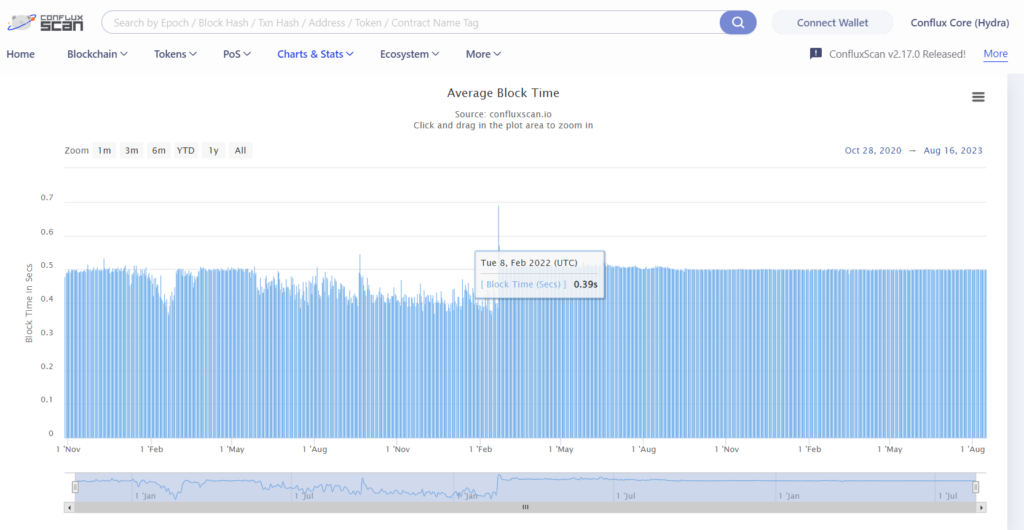Block time is a fundamental concept in blockchain technology that plays a crucial role in determining the speed and security of a blockchain network. In this article, we will explore the intricacies of block time, its implications on blockchain networks, and its significance in different consensus mechanisms.
Table of Contents
What is Block Time?

Block time is a term used in blockchain technology to describe the average amount of time it takes to add a new block to the blockchain. In simple terms, it’s the time interval between the creation of two consecutive blocks. Block time is crucial because it affects the speed at which transactions are confirmed on the blockchain.
In a blockchain network, transactions are grouped together into blocks, and these blocks are added to the blockchain in a sequential order. The process of adding a new block is known as “mining” in proof-of-work networks or “forging” in proof-of-stake networks. The time it takes to complete this process is the block time.
The block time is determined by factors such as the consensus mechanism used by the network, the network’s mining difficulty, and the computational power of the network’s participants. It plays a key role in the network’s security, performance, and the rewards earned by miners or validators.
Factors Affecting Block Time
Chart: Factors Affecting Block Time
| Factor | Description | Impact on Block Time |
|---|---|---|
| Consensus Mechanism | Rules for adding new blocks and resolving conflicts | Varies by mechanism |
| Mining Difficulty | Complexity of cryptographic puzzles in PoW networks | Directly proportional |
| Network Congestion | Number of transactions waiting to be included in the next block | Inversely proportional |
| Computational Power | Total computational power of the network’s participants | Inversely proportional |
| Network Latency | Time for data to travel from one point to another in the network | Directly proportional |
| Block Size | Maximum amount of data that can be included in a block | Directly proportional |
Consensus Mechanism
The consensus mechanism is a set of rules that determines how new blocks are added to the blockchain and how conflicts are resolved. Different consensus mechanisms, such as proof-of-work (PoW) and proof-of-stake (PoS), have different block time dynamics.
Mining Difficulty
In PoW networks, miners compete to solve complex cryptographic puzzles, and the first miner to solve the puzzle gets to add the next block to the blockchain. The mining difficulty is adjusted periodically to ensure that the block time remains relatively constant.
Network Congestion
Network congestion occurs when there are more transactions waiting to be included in the next block than the network can handle. In such cases, miners prioritize transactions with higher fees, leading to longer confirmation times for low-fee transactions.
Computational Power
The total computational power of the network’s participants affects the block time. In PoW networks, a higher total computational power can lead to faster block times, as miners can solve the cryptographic puzzles more quickly.
Network Latency
Network latency refers to the time it takes for data to travel from one point to another in the network. Higher network latency can lead to longer block times, as it takes longer for new blocks to be propagated across the network.
Block Size
The block size is the maximum amount of data that can be included in a block. Larger blocks take longer to propagate across the network, leading to longer block times.
Block Time in Popular Cryptocurrencies
| Cryptocurrency | Block Time | Consensus Mechanism | Mining Difficulty Adjustment |
|---|---|---|---|
| Bitcoin (BTC) | 10 minutes | Proof-of-Work (PoW) | Every 2016 blocks |
| Ethereum (ETH) | 13 seconds | Proof-of-Work (PoW) | Dynamic |
| Litecoin (LTC) | 2.5 minutes | Proof-of-Work (PoW) | Dynamic |
| Cardano (ADA) | 20 seconds | Proof-of-Stake (PoS) | N/A |
| Ripple (XRP) | 4 seconds | XRP Ledger Consensus Protocol | N/A |
| Conflux (CFX) | 0.5 sec | POW+POS | Dynamic |
| Kaspa | 1 sec | POW | Dynamic |
| Alephium | 64 sec | POW | Dynamic |
Implications of Block Time on Blockchain Networks
Transaction Confirmation Time
Block time directly affects the time it takes to confirm a transaction on the blockchain. Shorter block times lead to faster transaction confirmations, while longer block times result in slower confirmations. This has implications for the usability of a blockchain network, especially for applications that require quick transaction confirmations.
Network Security
Block time plays a crucial role in the security of a blockchain network. Shorter block times can increase the risk of double-spending attacks, as attackers have less time to reverse a transaction. On the other hand, longer block times may reduce the risk of such attacks but can also make the network more vulnerable to 51% attacks, where a single entity gains control of the majority of the network’s mining power.
Network Throughput
Block time affects the network’s throughput, which is the number of transactions the network can process per unit of time. Shorter block times can increase the network’s throughput, as more blocks are added to the blockchain in a given time period. However, this can also lead to an increase in the size of the blockchain, making it more challenging to store and synchronize.
Mining Rewards
In proof-of-work (PoW) networks, miners compete to add new blocks to the blockchain and are rewarded with newly minted cryptocurrency and transaction fees. The block time determines how often these rewards are distributed. Shorter block times result in more frequent rewards, while longer block times lead to less frequent rewards.
Network Stability
Block time affects the stability of the blockchain network. Shorter block times can lead to more frequent forks, where the blockchain splits into multiple branches. This can create confusion and uncertainty among network participants. Longer block times reduce the likelihood of forks but can also make the network less responsive to changes in transaction demand.
Decentralization
Block time has implications for the decentralization of the blockchain network. Shorter block times may favor miners with higher computational power, as they can solve the cryptographic puzzles more quickly. This can lead to centralization of the network, as a few powerful miners dominate the mining process. Longer block times can help level the playing field and promote decentralization.
Block Time and Mining
Block time is a crucial factor in the mining process of proof-of-work (PoW) blockchain networks. It directly affects the mining rewards, network security, and overall mining experience.
Mining Rewards Frequency
Block time determines how often miners receive rewards for successfully adding new blocks to the blockchain. Shorter block times result in more frequent rewards, making mining more attractive. However, this can also lead to higher inflation rates for the cryptocurrency.
Mining Competition
Shorter block times can intensify competition among miners, as they have less time to solve the cryptographic puzzles required to add new blocks. This can lead to higher energy consumption and increased centralization, as only miners with powerful hardware can keep up with the competition.
Block Time in Proof-of-Stake (PoS) Networks
Block time in PoS networks affects the validator selection process, staking rewards, and overall network performance.
Validator Selection Frequency
Block time determines how often validators are chosen to create new blocks. Shorter block times result in more frequent validator selection, allowing more participants to actively engage in the network’s consensus process.
Staking Rewards Frequency
Similar to mining rewards in PoW networks, block time affects how often validators receive staking rewards in PoS networks. Shorter block times lead to more frequent rewards, incentivizing more participants to stake their coins.
Network Responsiveness
Shorter block times make the network more responsive to changes in transaction demand. However, this can also increase the risk of forks, as validators may propose conflicting blocks simultaneously due to network latency.
Finality
Some PoS networks implement mechanisms to achieve finality, where a block is considered irreversible once added to the blockchain. Block time affects the speed at which finality is reached, impacting the network’s ability to prevent double-spending attacks and ensure transaction immutability.
Future Developments in Block Time
Adaptive Block Time Algorithms
One potential development is the implementation of adaptive block time algorithms that can adjust the block time dynamically based on network conditions. This could help optimize transaction confirmation times, network security, and overall network performance.
Layer 2 Solutions
Layer 2 solutions, such as the Lightning Network for Bitcoin and the Raiden Network for Ethereum, are being developed to improve transaction speeds and scalability. These solutions operate on top of the main blockchain and can process transactions with shorter confirmation times, effectively reducing the impact of block time on transaction speeds.
Sharding
Sharding is a technique that divides the blockchain into smaller, parallel chains called shards. Each shard processes its transactions independently, allowing for faster transaction confirmation times. Sharding can help mitigate the limitations of block time by increasing the overall network throughput.
Hybrid Consensus Mechanisms
Some blockchain networks are exploring hybrid consensus mechanisms that combine proof-of-work (PoW) and proof-of-stake (PoS) elements. These hybrid systems can leverage the security of PoW with the energy efficiency and scalability of PoS, potentially leading to optimized block times.
Cross-Chain Interoperability
As the blockchain ecosystem grows, there is an increasing need for interoperability between different blockchain networks. Cross-chain solutions, such as Polkadot and Cosmos, aim to enable seamless communication between blockchains with different block times, consensus mechanisms, and network parameters.
Optimized Network Parameters
Blockchain networks are continuously refining their network parameters, including block time, to achieve a balance between security, decentralization, and performance. Future developments may involve further optimization of block time based on empirical data and network usage patterns.
Quantum Computing
The advent of quantum computing could significantly impact block time, as quantum computers can solve cryptographic puzzles much faster than classical computers. Blockchain networks may need to adjust their block time and consensus mechanisms to account for the increased computational power of quantum computers.
Conclusion
Block time is a fundamental concept in blockchain technology that affects various aspects of a blockchain network, including transaction confirmation times, network security, throughput, mining rewards, and decentralization. It is a critical parameter that is carefully considered in the design of blockchain networks.
In proof-of-work (PoW) networks, block time is closely related to the mining process, where miners compete to solve cryptographic puzzles and add new blocks to the blockchain. Block time affects the frequency of mining rewards, the intensity of mining competition, and the occurrence of orphaned blocks.
In proof-of-stake (PoS) networks, block time affects the validator selection process, staking rewards, network responsiveness, and finality. PoS networks aim to achieve a balance between security, decentralization, and performance by optimizing block time and other network parameters.
Future developments in block time may involve adaptive block time algorithms, Layer 2 solutions, sharding, hybrid consensus mechanisms, cross-chain interoperability, optimized network parameters, and the impact of quantum computing. These developments aim to enhance the security, scalability, and performance of blockchain networks while maintaining decentralization.
In conclusion, block time is a crucial factor that shapes the dynamics of blockchain networks. Balancing block time with other network parameters is essential for achieving a secure, decentralized, and efficient blockchain network. As the blockchain ecosystem continues to evolve, block time will remain a key consideration in the design and optimization of blockchain networks.
FAQs
What is block time in blockchain technology?
Block time refers to the average time it takes for a new block to be added to the blockchain.
How does block time affect blockchain networks?
Block time affects the speed of transactions, network throughput, and security of a blockchain network.
What factors influence block time?
Network congestion, mining difficulty, and transaction fees are some factors that affect block time.


